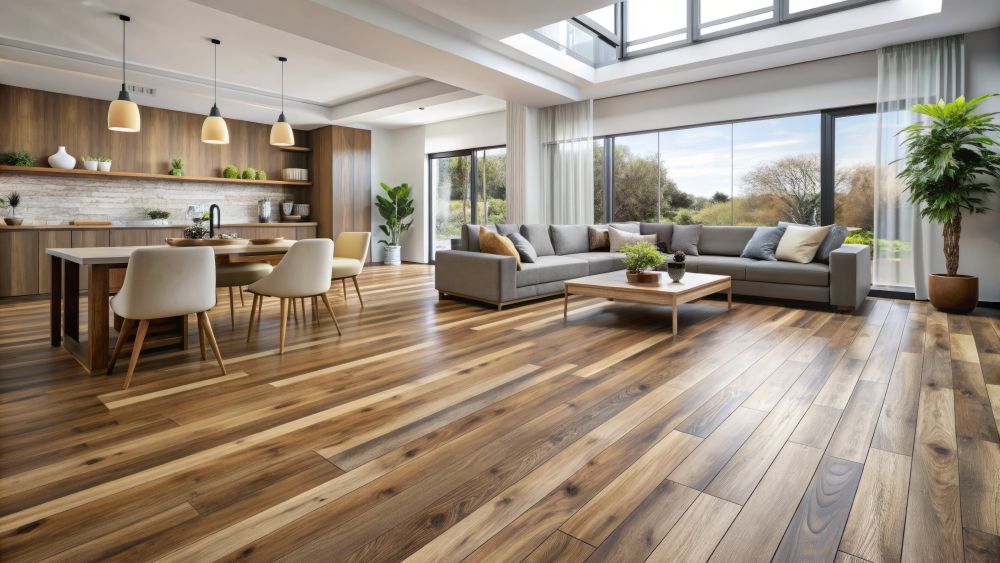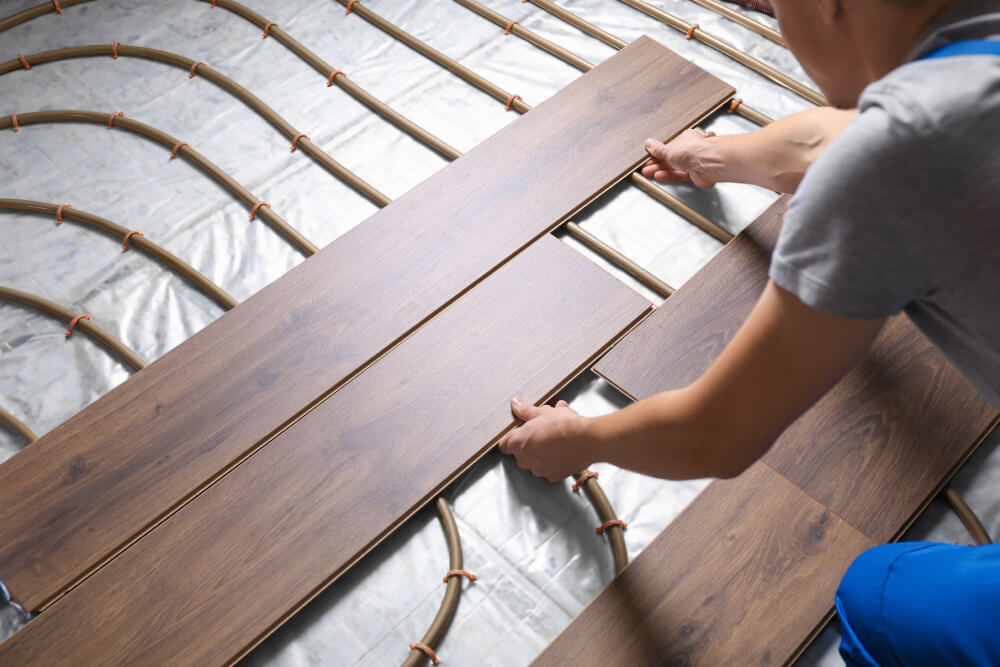1. Understanding Carpet Fiber Types
The fiber type is one of the most critical aspects to consider when selecting carpet flooring. Different fibers offer unique characteristics, such as durability, stain resistance, and softness. Here are the main carpet fiber types:
- Nylon: Nylon is the most popular carpet fiber due to its durability, resilience, and versatility. It is suitable for high-traffic areas and holds up well over time.
- Durability: Highly resilient and resistant to wear, making it ideal for high-traffic areas.
- Stain Resistance: Often treated with stain-resistant coatings, making it easier to clean.
- Versatility: Available in a wide range of colors and styles.
- Softness: Offers a comfortable underfoot feel.
- Cost: Generally more expensive than other synthetic fibers.
- Static Electricity: Can generate static electricity, though many treatments are available to reduce this issue.
- Polyester: Polyester is known for its luxurious appearance and softness. It is a popular choice for low-traffic areas and is often more affordable than nylon.
- Softness: Extremely soft and comfortable underfoot.
- Stain Resistance: Naturally stain-resistant and often treated to enhance this property.
- Color Fastness: Resists fading and maintains vibrant colors.
- Eco-Friendly Options: Some polyester carpets are made from recycled materials, such as plastic bottles.
- Durability: Less durable than nylon and may not hold up as well in high-traffic areas.
- Crushing: Prone to crushing and matting over time, especially in areas with heavy furniture.
- Olefin (Polypropylene): Olefin is a budget-friendly option that offers good stain resistance and moisture resistance. It is often used in indoor/outdoor carpets.
- Stain Resistance: Highly resistant to stains and moisture.
- Affordability: Generally less expensive than nylon and polyester.
- Color Fastness: Resists fading, even in direct sunlight.
- Mildew and Mold Resistance: Suitable for damp or outdoor areas.
- Durability: Less durable than nylon, making it less suitable for high-traffic areas.
- Crushing: Prone to crushing and matting, particularly in areas with heavy foot traffic.
- Wool: Wool is a natural fiber that offers exceptional softness, luxury, and durability. It is considered a premium carpet fiber and is often more expensive than synthetic options.
- Softness: Extremely soft and luxurious underfoot.
- Durability: Highly durable and resilient, with natural elasticity.
- Eco-Friendly: A renewable and biodegradable resource.
- Flame Resistance: Naturally flame-resistant without chemical treatments.
- Cost: Generally more expensive than synthetic fibers.
- Stain Susceptibility: Prone to staining and may require special cleaning products.
- Moisture Sensitivity: Can absorb moisture, making it less suitable for damp areas.
- Triexta (PTT): Triexta is a relatively new synthetic fiber that combines the durability of nylon with the softness and stain resistance of polyester. It is marketed under brand names such as SmartStrand.
- Durability: Highly durable and resilient, suitable for high-traffic areas.
- Stain Resistance: Excellent stain resistance without the need for additional treatments.
- Softness: Offers a soft and comfortable underfoot feel.
- Eco-Friendly Options: Some triexta carpets are made from renewable resources, such as corn glucose.
- Cost: Can be more expensive than traditional polyester but generally less than nylon.
- Availability: Limited availability compared to more established fibers like nylon and polyester.
Join HICP Homeowner’s Alliance
Connect with experts, get special discounts and enjoy member benefits
2. Exploring Carpet Styles
In addition to fiber types, carpet styles play a significant role in determining the look, feel, and performance of your carpet. The primary carpet styles include cut pile, loop pile, and cut-and-loop pile.
- Cut Pile: Cut pile carpets are made by cutting the yarn loops, resulting in upright fibers. This style is known for its softness and is available in various sub-styles.
- Saxony: Features tightly twisted fibers that stand upright, creating a smooth and velvety surface. Saxony is ideal for formal settings but may show footprints and vacuum marks.
- Plush (Velvet): Similar to Saxony but with a more densely packed fiber arrangement, giving it a luxurious and smooth appearance. Plush carpets are best suited for low-traffic areas.
- Frieze: Features highly twisted fibers that create a textured and informal look. Frieze carpets are durable and effective at hiding footprints and dirt.
- Cable: Made from thicker, longer fibers that provide a cozy and comfortable feel. Cable carpets are ideal for bedrooms and family rooms but may show signs of wear in high-traffic areas.
- Loop Pile: Loop pile carpets are made by looping the yarn fibers through the backing, creating a durable and textured surface. This style is often used in commercial settings and high-traffic areas.
- Berber: Characterized by large, thick loops that provide a durable and textured surface. Berber carpets are known for their resistance to wear and their ability to hide dirt and stains.
- Level Loop: Features loops of uniform height, creating a smooth and durable surface. Level loop carpets are ideal for high-traffic areas and commercial use.
- Multi-Level Loop: Features loops of varying heights, creating a textured and patterned appearance. Multi-level loop carpets add visual interest and are suitable for various settings.
- Cut-and-Loop Pile: Cut-and-loop pile carpets combine both cut and looped fibers, creating a patterned and textured surface. This style offers a balance of durability and aesthetics.
- Patterned: Combines cut and looped fibers to create geometric or abstract patterns. Patterned carpets add visual interest and are effective at hiding stains and dirt.
- Textured: Features a combination of cut and looped fibers to create a textured surface with a casual and informal look. Textured carpets are versatile and suitable for various settings.
3. Choosing the Right Carpet for Your Home
When selecting carpet flooring for your home, consider the following factors to ensure you choose the right fiber type and style for your needs:
- Room Usage:
For high-traffic areas such as hallways, living rooms, and stairs, choose durable fibers like nylon or triexta and styles like frieze or Berber that can withstand wear and hide dirt.
Low-Traffic Areas:For bedrooms and formal living rooms, consider softer and more luxurious options like plush or Saxony made from wool or polyester.
- Budget:
Determine your budget and choose a carpet fiber and style that fits within your price range. Nylon and triexta tend to be more expensive, while polyester and olefin offer budget-friendly options.
Long-Term Investment:Consider the long-term value of your carpet choice. Higher-quality fibers like nylon and wool may have a higher upfront cost but offer greater durability and longevity.
- Maintenance:
Choose a fiber with good stain resistance if you have pets, children, or frequently host guests. Triexta, nylon, and polyester are excellent choices for stain resistance.
Cleaning Requirements:Consider the cleaning and maintenance requirements of the carpet. Some fibers and styles may require more frequent cleaning and care to maintain their appearance.
- Aesthetic Preferences:
Select a color and pattern that complements your home’s decor and hides dirt and stains. Lighter colors can make a room appear larger, while darker colors can add warmth and coziness.
Texture and Style:Choose a carpet style that fits your desired aesthetic and functional needs. Consider the feel underfoot, the appearance of footprints and vacuum marks, and the overall look of the carpet.
4. Caring for Your Carpet
Proper care and maintenance are essential to prolong the life and appearance of your carpet. Here are some tips for keeping your carpet in excellent condition:
- Regular Vacuuming:
Vacuum high-traffic areas at least twice a week and low-traffic areas once a week to remove dirt, dust, and debris.
Technique:Use a vacuum cleaner with adjustable height settings and a beater bar or brush roll for the best results. Vacuum in different directions to lift and remove embedded dirt.
- Spot Cleaning:
Clean spills and stains as soon as they occur to prevent them from setting into the fibers. Blot the spill with a clean, absorbent cloth and avoid rubbing, which can spread the stain.
Cleaning Solutions:Use a mild carpet cleaner or a mixture of water and white vinegar for spot cleaning. Test the solution on an inconspicuous area first to ensure it doesn’t damage the carpet.
- Professional Cleaning:
Have your carpet professionally cleaned every 12-18 months, or more frequently if you have pets, children, or allergies.
Methods:Steam cleaning (hot water extraction) is recommended for most carpets, as it effectively removes deep-seated dirt and allergens. Dry cleaning methods are also available for quick drying times.
- Preventative Measures:
Use furniture coasters or pads to prevent dents and damage from heavy furniture. Rearrange furniture periodically to distribute wear evenly.
Area Rugs and Runners:Place area rugs and runners in high-traffic areas to protect the carpet and reduce wear. Use non-slip pads to keep them in place.
Entry Mats:Use entry mats at doorways to reduce the amount of dirt and debris tracked onto the carpet.
Conclusion:
Understanding the different carpet fiber types and styles is essential for selecting the right carpet for your home. Each fiber type offers unique benefits and drawbacks, making it important to consider factors such as durability, stain resistance, softness, and budget. Similarly, the various carpet styles, including cut pile, loop pile, and cut-and-loop pile, provide different aesthetics and performance characteristics.
By carefully evaluating your needs, preferences, and the specific requirements of each room, you can choose a carpet that enhances the comfort, beauty, and functionality of your home. With proper care and maintenance, your carpet flooring will continue to provide warmth, comfort, and style for many years to come.








